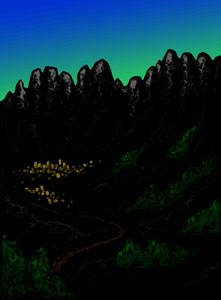The Ordein |
|||
|
Navigation |
As the
Empire itself dissolved as a political force, the
populations of the varied lands of Greenhall became
even more conscious of the Empire as an ideal. The
Empeira, as it was known in Olimac and the other
lands of the east, held out the promise of a
universal political and social reality, in which
everything and everyone had its place, The
realities of the political machinations of the
various nation-states and kingdoms could be
subsumed under a larger envelope of order and
hierarchy, however fictive. The
belief in the reality and relevance of the Empeira
depended on a social code that could be relied upon
to organize and channel human behavior across the
whole breadth of the continent. The Ordein thus
established a set of particular social expectations
that maintained a kind of cultural unity throughout
the Greenhall, even society fragmented
linguistically and politically. The
Ordein was a body of civil laws, to be sure, but it
was much more extensive and persuasive than its
purely legal manifestations. Most of its most
salient principles were never articulated. Notions
of honorable conduct between peers, for example,
were not limited to specific rules of etiquette,
but dictated, in a subtle fashion, even the nuances
of body posture, gesture, and tone of voice. Rules
for everything from dining to courtship became
ingrained and stabilized, varying little from place
to place. Old
concepts of patronage were generalized to create a
permeable class system, in which individuals of
different social standing could negotiate
arrangements of exchange and collaboration that
would have been unthinkable in the Time of Empire.
It was this development that launched the economies
of trade for which the Time of Riches is noted. The
prospect of rising to the power of the elite
classes through shrewd use of resources and
interpersonal contacts, though seldom realized in
fact, created an enormous incentive for many people
who might otherwise have lived lives of resigned
drudgery. Paradoxically,
the Ordein was both liberating and oppressive. It
allowed for the movement of wealth, technology, and
people of status between countries and social
classes, but it resisted innovation in the rules of
the game by which such exchanges took place. After
its successful establishment, people of power (and
people seeking power) became dependent upon
it. The mechanisms for securing personal success
could not be tinkered with or questioned, for fear
of throwing the whole system into disarray. The
stakes were very high for an individual trying to
maintain a position of power within an intricate
web of social connections. Even a slight faux
pas in living up to the expectations enshrined
in the Ordein could make one into a pariah.
As
time passed, the Ordein became a progressively
heavier burden on human activity. Such intense
attention was devoted to the niceties and
appearances of personal conduct that few resources
were left for actually producing things of value or
exploring new prospects. Were it not for the fact
that the rural labor force was general less
ambitious and hence less concerned with the nuanced
requirements of the Ordein, even the provision of
food and shelter might have dwindled and
stagnated. Whatever
its blessings and curses for the lives and hopes of
individual people, there is no doubt that the
Ordein was the key factor in stablizing Greenhall
society over many centuries. It was a pattern
which, once established, was extraordinarily
self-sustaining and impervious to
disruption. Copyright © 2008 Tom Waters |
||
 t
has been argued that it was the establishment of
the Ordein, more
than any other single innovation, which made
possible the transition from the Time of Empire to
the Time of Riches. It is ironic, then, that the
Ordein was always coceived by those who lived under
it as a solidification of the ordering of imperial
society.
t
has been argued that it was the establishment of
the Ordein, more
than any other single innovation, which made
possible the transition from the Time of Empire to
the Time of Riches. It is ironic, then, that the
Ordein was always coceived by those who lived under
it as a solidification of the ordering of imperial
society.